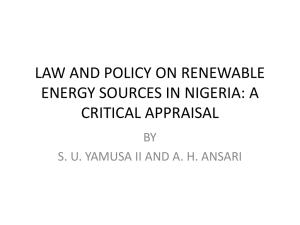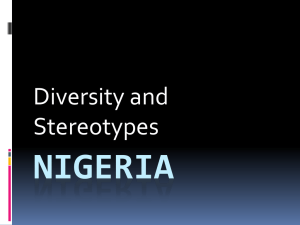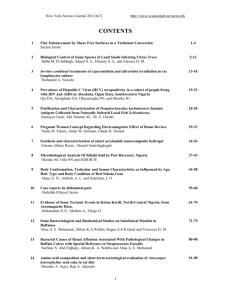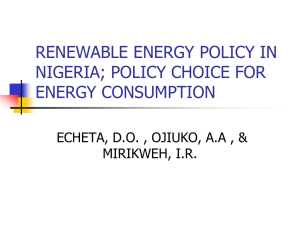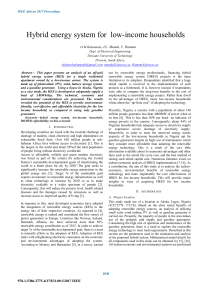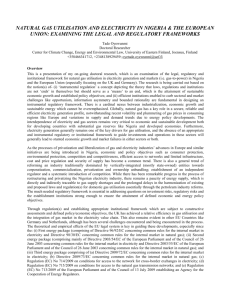2. Electricity in Africa
advertisement
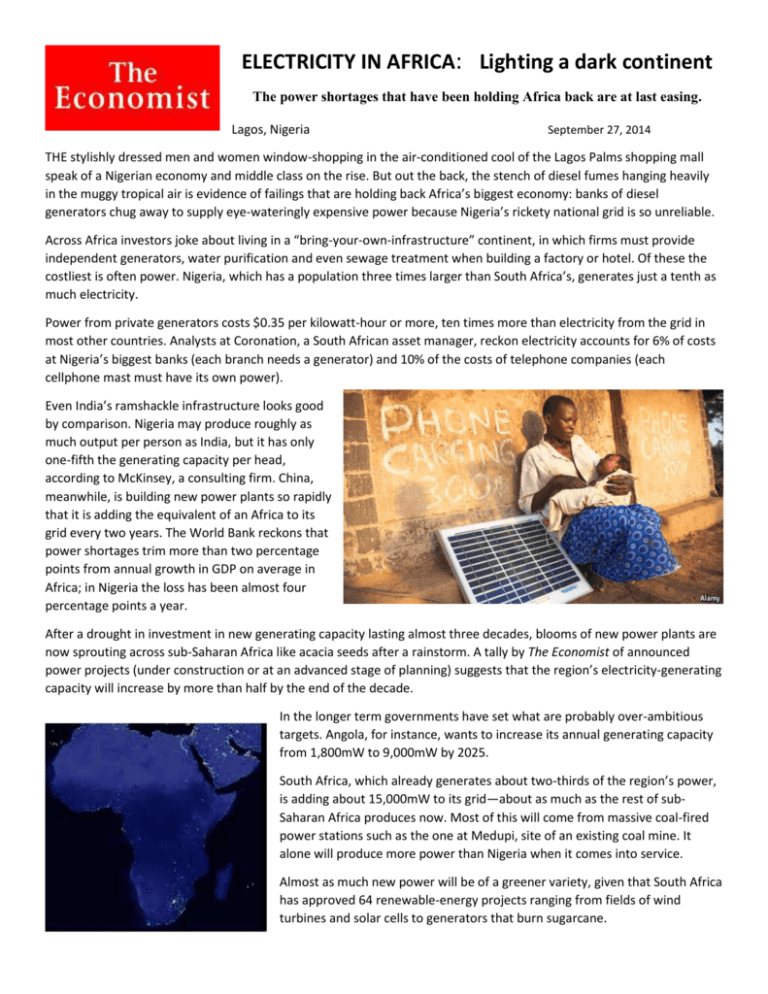
ELECTRICITY IN AFRICA: Lighting a dark continent The power shortages that have been holding Africa back are at last easing. Lagos, Nigeria September 27, 2014 THE stylishly dressed men and women window-shopping in the air-conditioned cool of the Lagos Palms shopping mall speak of a Nigerian economy and middle class on the rise. But out the back, the stench of diesel fumes hanging heavily in the muggy tropical air is evidence of failings that are holding back Africa’s biggest economy: banks of diesel generators chug away to supply eye-wateringly expensive power because Nigeria’s rickety national grid is so unreliable. Across Africa investors joke about living in a “bring-your-own-infrastructure” continent, in which firms must provide independent generators, water purification and even sewage treatment when building a factory or hotel. Of these the costliest is often power. Nigeria, which has a population three times larger than South Africa’s, generates just a tenth as much electricity. Power from private generators costs $0.35 per kilowatt-hour or more, ten times more than electricity from the grid in most other countries. Analysts at Coronation, a South African asset manager, reckon electricity accounts for 6% of costs at Nigeria’s biggest banks (each branch needs a generator) and 10% of the costs of telephone companies (each cellphone mast must have its own power). Even India’s ramshackle infrastructure looks good by comparison. Nigeria may produce roughly as much output per person as India, but it has only one-fifth the generating capacity per head, according to McKinsey, a consulting firm. China, meanwhile, is building new power plants so rapidly that it is adding the equivalent of an Africa to its grid every two years. The World Bank reckons that power shortages trim more than two percentage points from annual growth in GDP on average in Africa; in Nigeria the loss has been almost four percentage points a year. After a drought in investment in new generating capacity lasting almost three decades, blooms of new power plants are now sprouting across sub-Saharan Africa like acacia seeds after a rainstorm. A tally by The Economist of announced power projects (under construction or at an advanced stage of planning) suggests that the region’s electricity-generating capacity will increase by more than half by the end of the decade. In the longer term governments have set what are probably over-ambitious targets. Angola, for instance, wants to increase its annual generating capacity from 1,800mW to 9,000mW by 2025. South Africa, which already generates about two-thirds of the region’s power, is adding about 15,000mW to its grid—about as much as the rest of subSaharan Africa produces now. Most of this will come from massive coal-fired power stations such as the one at Medupi, site of an existing coal mine. It alone will produce more power than Nigeria when it comes into service. Almost as much new power will be of a greener variety, given that South Africa has approved 64 renewable-energy projects ranging from fields of wind turbines and solar cells to generators that burn sugarcane. In other countries most of the new energy will be renewable or from gas, which is cleaner than coal. Ethiopia is building Africa’s largest hydroelectric and geothermal plants. Between them the two projects will triple the country’s power production. Kenya is drilling holes deep into the Rift Valley in Hell’s Gate National Park to build what will ultimately be the world’s largest single geothermal plant. At Lake Turkana, a particularly windy spot farther north in the Rift Valley, private investors are building Africa’s biggest wind farm. Two forces are driving the expansion. First, a number of African countries have either opened their markets to private investors or adopted clearer regulations that encourage investment. Take South Africa. For years it insisted that new capacity should be built only by the state-owned generator, Eskom. But in 2008 the country experienced crippling power shortages that forced mines and factories to cut production and sent millions of South Africans to bed early. The government reversed course and encouraged private investment in renewable energy sources. Nigeria last year privatized state-owned distribution companies, while Kenya, Ghana and Tanzania are all attracting foreign investment. Anton Eberhard of the University of Cape Town reckons that, although investment by governments in power has largely remained stable, there have been big increases from other investors, including Chinese state-owned firms. A second factor is the rapidly falling cost of renewable energy. Africa has some of the world’s best potential sites for wind, solar and hydropower. Investors are proving readier to test the market by putting up a few windmills than by committing to big power stations. Wind farms and solar parks can also provide decentralized or “off-grid” power directly to customers, reducing the load on congested transmission lines. Given the high cost of power from diesel generators in Africa, renewable energy can be an attractive alternative. Ahmed Heikal, chairman of Qalaa Holdings, an investment firm with holdings in several power producers, thinks that in Africa a “new model [of renewable energy] that bypasses the government is emerging”. It is one in which firms are able to offer competitively priced renewable power without the hefty government subsidies needed to encourage investment elsewhere, such as solar parks in cloudy Germany or offshore wind farms in the rough waters of the North Sea. Africa has the potential to jump from being the world’s electricity laggard to a leader in renewables—if inefficient governments don’t hold it back. http://www.economist.com/news/middle-east-and-africa/21620245-power-shortages-have-been-holding-africa-back-are-last-easing-lighting
